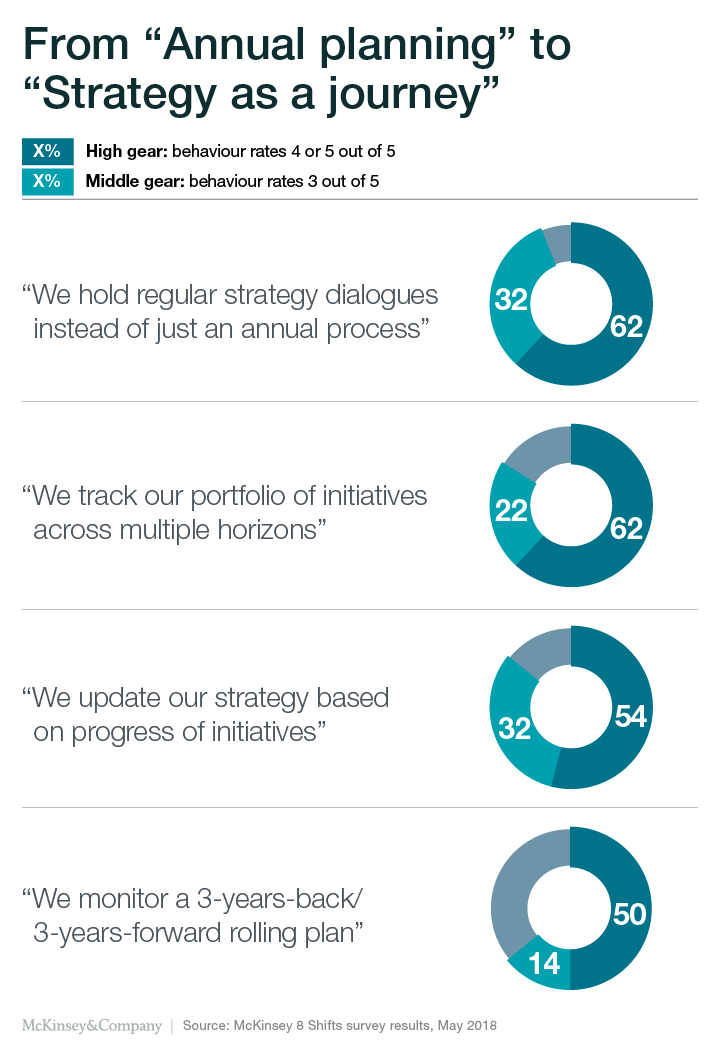I regularly hear business leaders complain about wanting to reallocate resources to attractive growth opportunities but discovering those resources are as sticky as glue, or finding their efforts at bold strategies sandbagged by risk-averse managers. Corporate politics, cognitive biases, the sway of individual incentives—such challenges have long plagued strategy development, but while they are intractable, they are not insurmountable.
Over the past few months, my colleagues Martin and Chris and I have explored the social dynamics that undermine decisions and breed incrementalism, and ways in which companies can use empirical benchmarks to determine the odds of their strategies succeeding. We’ve also laid out the types of big moves most likely to bring major performance boosts. But the question that remains in many executives’ minds is, “What does all this mean for how I run my strategy process and lead my team?”
There are eight shifts you can make to address this dilemma. These are practical changes you can start implementing tomorrow morning which, applied together, will enable you to change what happens in your strategy room.
Over the coming weeks, we will explain them one by one, starting with…
Shift 1: From annual planning…to strategy as a journey
When I ask business leaders where they made their most consequential strategy decision, the answer is rarely, “In the strategy room.” I’m more likely to hear, “In the shower before I went to meet my senior team,” or “Over that dinner conversation with the CEO of my major customer.” As important as a regular planning cycle may be for ensuring that all important questions are discussed with the team, a once-a-year strategy review is poorly suited to the dynamic nature of today’s business environment. In fact, trying to solve your big strategic questions and lock down an agreed plan at the same time can be nearly impossible. You can be sure the urgent will dominate the important, and those big strategic questions won’t get the air-time they need. Besides, the messy non-linear and uncertain strategy issues don’t fit into the linear world of the three- to five-year plan.
Even if the dynamics in the strategy room were perfect, the world doesn’t unfold in neat annual increments. Potential deals do not occur when you have your annual board strategy session; they occur when they occur, and you need to be ready. That requires reviewing performance and some of the key strategic questions every week or month.
Hold regular strategy discussions
Say you trimmed your annual planning process to the bare minimum (I can almost hear you sigh with relief). Then, launch more regular, incisive strategy conversations with your team, perhaps as a fixed part of your monthly management team meeting. To make those check-ins productive, start maintaining a “live” list of the most important strategic issues, a roster of planned big moves, and a pipeline of initiatives for executing them.
This approach will get you a lot closer to achieving continuous engagement on strategy. Every time you meet as a team, you quickly update each other on the state of the market and your business, then reflect on the big issues, moves, and initiatives. You consider whether the initiatives remain appropriate, should be modified, or should be stopped. Every time you meet, you also do a deep dive into one or a few topics of opportunity or concern. In this way, the strategy process becomes a journey of regularly checking assumptions, verifying whether the strategy needs refreshment, and exploring whether the context has changed so much that an entirely new strategy is necessary.
To understand what this process looks like in action, consider the Managing the strategy journey whose competitive context dramatically changed following the financial crisis. The CEO realized that both the bank’s strategy and its approach to refining it over time needed revamping. He instituted biweekly meetings with the heads of the three major units to identify new sources of growth. After making a set of “no-regrets” moves (such as exiting some noncore businesses and focusing on balance-sheet optimization), the bank’s strategy council devoted subsequent meetings to confronting decisions whose timing and sequence demanded close evaluation of market conditions. The top team defined these choices as “issues to be resolved,” regularly reviewed them, and developed a process for identifying, framing, and prioritizing the most time-sensitive strategic challenges. In doing so, the team not only jump-started its new strategy but launched an ongoing journey to refine it continually.
Track your portfolio of initiatives
Your strategy should evolve like a pipeline of initiatives working through different stage-gates. Long-dated and prospective ideas will be like “real options” that require learning and achieving familiarity. For initiatives that involve scaling growth in a three-year time horizon, the emphasis will be on managing capital investments, achieving milestones, and showing strong user acceptance. For short-term ventures and ones in highly familiar territory, you will be looking at in-year financial delivery. The pipeline should have movement in it, too—it’s designed to flow over time rather than be a “set and forget” plan.
The benefit? People will know that they will be continually accountable, so they will be less likely to sandbag or make bold claims in a bid for resources—and if they do, the offenses will become apparent a lot sooner and be easier to catch. Those false hockey sticks happen because of the disconnection between the five-year strategy and the one-year operating plan. And because you are staying on top of what is happening and why around your big strategic moves, you can more easily stem the tendency to attribute success to management excellence and failure to one-off events.
Monitor a rolling plan
You still need to develop a plan and a budget, of course. You may continue a bare-bones annual process, but you will be better off moving to a rolling, 12-month plan that you update as needed. You could also keep a two- to 10-year plan front and center at the strategy sessions, one that you adjust if you change initiatives, priorities, and big moves. Every big move leads to an update of the expected trajectory of the business.
Tencent is one company that has adopted a highly adaptable strategy process in order to react immediately to changes in the marketplace. In some years, the company makes hundreds of acquisitions, so it’s constantly changing and moving based on new information. Tencent has a broad strategic direction toward developing its platform, but the fundamentals—the big moves—change as a result of a continuing dialogue among the management team and in reaction to changes in the business context.
Ultimately, shifting from annual strategy meetings to an ongoing and continuous strategy process will make you more responsive, potentially giving you a competitive edge. But keep in mind that more and more companies are moving in this direction. When we recently polled executives on how they approach strategy development, almost one-third said their organizations have put this shift into a “high gear”—the second-highest ratio of all eight shifts we surveyed.

Sven Smit is a senior partner in our Amsterdam office, leader of our Western European region, and co-author of Strategy Beyond the Hockey Stick with Martin Hirt and Chris Bradley.
This article originally appeared on LinkedIn.
